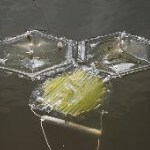energy
Maybe this could fall under my "physics of parkour". It could also apply to the MythBusters "dumpster diving" episode. In both of these cases, the question is: how far can you jump off of something and not severely hurt yourself. They do this a lot in parkour. Here are some examples:
There are a ton of these things on youtube. Let me go ahead and say it. I would not recommend trying any of this stuff. Even reading this blog won't adequately prepare you. So, if you go ahead and try to do some cool jump, don't blame me for your injuries.
Now that the warning is out there - let me get on…
The more I think about the last MythBusters' exploding water heater, the more cool things I see. How about I look at the energy of the explosion. There are three things I can look at:
How much energy went into the water heater from the electric source?
How much kinetic energy did the water heater have right after the explosion?
How much thermal energy did the water and water heater have?
How much gravitational potential energy did the heater have at it's highest point?
Hopefully, I can show that the energy in from the electric source is greater or equal to kinetic plus thermal. Also, the…
...and how Levitt and Dubner fail to see that the Manure problem was not 'solved', only turned into a new problem that will also require wrenching change. First, the Great Manure Crisis of the late nineteenth century:
The standard horsecar, which seated twenty, was drawn by a pair of roans and ran sixteen hours a day. Each horse could work only a four-hour shift, so operating a single car required at least eight animals. Additional horses were needed if the route ran up a grade, or if the weather was hot. Horses were also employed to transport goods; as the amount of freight arriving at the…
Last night I saw the newest episode of MythBusters. One of the myths they revisited was the exploding water heater. Well, it turns out that I had an analysis of this first explosion, but I didn't move it over when I switched software. So, here it is.
In case you never saw the first episode of exploding water heaters, here is the important part:
If you are impatient, here are the answers (from the video analysis):
Time of flight = 11.8 seconds
Max height = 167 meters = 548 feet
Launch speed = 234 mph
Speed on impact with the ground = 76 mph
First, from re-watching the video, I can see (…
(from here)
When you think about it, it seems pretty obvious (rising to the level of "duh!") that if one placed a wind turbine underwater it could be more efficient and, unlike wind power, ocean currents are far more predictable (of course, like most good ideas, it's obvious after someone else thought it...). A spinoff of the Saab corporation is developing such a system:
A completely new concept of underwater wave energy using a simple 7 ton kite turbine design has been developed by Minesto; which is a spinoff from the Swedish military and aircraft design firm Saab. The Deep Green…
I really shouldn't do this. I might be helping someone to set up something dangerous. But, I am going to anyway. Here is a question posted on some forum. (actually, it is from math help forum)
"I'm anticipating a good winter this year, one with lots of snow. My yard is sloped quite a bit and it would be the ideal place for a huge snowboard jump, only problem is I need to calculate how fast I will be traveling when I hit the jump, how high and what angle the jump should be, and the distance and angle of the landing ramp to optimize my range."
So, what am I going to do? I am going to give…
This weekend, ScienceBloggers discussed the virtues and downfalls of a world run on modern nuclear power. Benjamin Cohen sparked the dialogue on The World's Fair with an interview with author and environmentalist Rebecca Solnit, famous for her opposition to nuclear power. Within just a few hours, Built on Fact's Matt Springer responded, categorically arguing against Solnit's piece and citing events at Chernobyl as an overly hyped specter. "Chernobyl is to modern nuclear power as bloodletting is to penicillin," he says. Ethan Siegel followed in suit on Starts with a Bang, where he offered…
I love this story. It is a story of how ideas changed about the nature of the atom. These are the notes (and diagrams) I use when I teach the atomic nature of matter to non-science majors. The best thing about this story is that it is a great example of science. Science (or scientists) build a model. If new evidence comes along, the model gets changed. There are several other websites that describe all of this stuff, I will list a couple at the end of this post.
Typical textbook model of an atom
Look in an intro, non-science majors textbook and you will probably see a picture like this…
IEEE
href="http://spectrum.ieee.org/green-tech/fuel-cells/hydrogen-helper">reports
that chicken feathers are superior to carbon nanotubes:
src="http://photos-g.ak.fbcdn.net/hphotos-ak-snc1/hs148.snc1/5494_920199924833_2254023_51033310_7917444_s.jpg"
align="left" height="86" width="130">Scientists
at the University of Delaware say that carbonized chicken feathers
could be a cheap way to store hydrogen for fuel cells. According to
chemical engineering professor Richard Wool, the heat-treated feathers
could hold more hydrogen than costlier competing technologies, such as
metal hydrides…
This is amazing. I can't believe that power companies are paying Blacklight Power money, but they are. I guess Blacklight Power must have great advertising. Ok, so what is this whole Blacklight-hyrdino thing? Honestly, I am not fully familiar with it, but basically this guy says that you can get energy by getting the electron in hydrogen to go to a lower energy level than ground state. Here are a few good links regarding this hydrino stuff.
Six Tiny Utilities Buy "Scientifically Impossible" Energy: CleanTechnica
Blacklight Power claims nearly-free energy from water - is this for real…
What's the deal with the Chevy Volt? Well, obviously, it is a cool car. A plug-in hybrid. The problem is in how to quantify its efficiency. Normal hybrids (the non-plug in type) have only one type of energy input, gasoline. The Volt can take gasoline or electricity input. This makes it difficult to compare the efficiency of other cars. What is efficiency? There are several things you could calculate.
Actual MPG
This is the distance the car travels (the miles part) divided by how much gasoline it used (the gallons part). Pretty straight forward? Ah ha! Not so straight forward for…
July 4th can be fun. One activity my family enjoys is playing in the lake at my parents house. Along with this comes the jumping off the dock. Great fun, and great physics. Here is a short clip.
Work Energy Example from Rhett Allain on Vimeo.
Notice that I violated my own rules for making videos. In particular, the camera was not perpendicular to the motion. Also, I can handle panning cameras, but not when there is nothing but sky in the background. This video is therefore not appropriate for a video analysis. That is ok. I don't need it to talk about physics. So, here is the…
This was on my 'to do' list, but Tom at Swans on Tea beat me to it. Basically, this grocery store has these plates that when depressed produce electrical energy. Tom does a good job pointing out that this is not free energy (the original article says this also). Clearly, the energy comes from the cars. How much would this cost the cars?
As always, let me start with some assumptions.
The original article says that the bumps will generate 30 kW of energy every hour. That is an odd thing to say. I am going to interpret that as 30 kW of power for all hours (every hour). They couldn't have…
Note: This is an old post from the time before my blog was in wordpress. I noticed there was some incoming link for this, and I never moved it over. Here it is in it's unaltered (except for this part) format.
I don't know why I even suggest a new energy source. Fusion power is only a few years away in the future (just like it as always been). This will replace any other sources of energy that we could come up with. But, I can't help myself, I need to share my idea and save the world. It's what I do. (call me a superhero is you want).
We can get all of our energy from the rotation of the…
Maybe this isn't the best video to analyze, but it sure is funny. I am not sure why it is so funny - maybe you should just watch it first.
Sledgehammer Funby Stressmaker
I don't really know why these guys are putting explosive on sledge hammers. Sure it looks fun, but I think I would pass. Anyway, here is the part I was curious about.
Did the exploding hammer lift him off the ground, or did he jump as a reaction to the explosion. It kind of looks like he was lifted, but I am not sure that is possible. Video analysis to the rescue. (using Tracker Video) So, I assumed the sledge hammer…
This method, if it pans out, could not only be clean, it could make the
environment even cleaner.
Jonathan Trent, the lead research scientist on the Spaceship Earth
project at NASA Ames Research Center, has been working on a method to
produce oil from algae. Their Algal Biofuels Team appears to be
making progress.
style="display: inline;">
href="http://www.nasa.gov/centers/ames/news/features/2009/clean_energy_042209.html">NASA
Envisions "Clean Energy" From Algae Grown in Waste Water
NASA scientists have proposed an ingenious and remarkably
resourceful process to produce "…
What we know, Bill speaks:
I already knew, from my own modest experience installing and paying for installation of insulation and other energy-saving upgrades in my house, that such work is highly labor-intensive -- and so employs a lot of people per dollar spent. When we had our basement insulated, the material cost was perhaps $400; the total bill over $3000. Some of the difference was in equipment, but that was probably fairly modest. The big cost was clearly in paying two or three guys to make racket spraying goop in our basement for 3 or 4 days.
So it stands to figure that a good way…
The two major policy approaches to cutting carbon emissions, cap-and-trade and carbon taxes, both work by putting a price on pollution. Carbon tax—simply, a tax on fossil fuels—is intended to motivate businesses to conserve energy and switch to cleaner energy sources in order to save money. Cap-and-trade schemes put a limit on how much pollution a company is allowed. Companies that exceed their limit must then buy "carbon credits" from greener companies to compensate. Though these efforts have met with some success, our bloggers ask: is pricing carbon enough to stimulate investment in clean…
In January, Barack Obama promised in his inaugural address to "restore science to its rightful place." The pledge was a win for scientists everywhere, and particularly for those working in the US. But now, with the European Parliamentary (EP) elections at hand, whether Obama's sentiments are shared by politicians worldwide remains to be seen. Last Thursday through Sunday, members of the 27 member states of the European Union voted for representatives from seven parties to fill 736 seats in the EP. ScienceBlogger Frank Swain of SciencePunk, together with The Lay Scientist, sent a nine-…




